

TORONTO, Ont. (18/01/18) Ð Students of the University of Toronto marched together from their universities campus to Queens Park in Toronto to protest changes made to student fees and OSAP. The protest drew hundreds of students, eager to voice their dissent over the changes. Photo by Sasha Sefter
Student organizations furious
over education funding changes
By Shelby Lisk
The Ford government has unveiled their
plan to reduce tuition for Ontario postsecondary
students by 10 per cent.
“For the first time in Ontario, students
at every publicly assisted college and university
will see their tuition rates go down
by 10 per cent thanks to a province-wide
tuition rate reduction introduced by Ontario’s
Government for the People. The
tuition rate reduction is the latest step in
the Ford Government’s plan to keep more
money in the pockets of Ontario students
and families,” stated the Ontario government’s
official news release posted Jan. 17.
The release stated that, for example, an
arts and science undergrad at the University
of Guelph would see a reduction
in their tuition of $700 and a Conestoga
College student enrolled in practical
nursing would see a decrease of $300 in
their 2019-2020 tuition.
While a decrease in tuition sounds like
happy news for students, the announcement
came at the same time as proposed
cuts to the Ontario Student Assistance
Program, or OSAP, and the introduction
of a new program, “the student choice
initiative,” which will allow students to
opt out of paying ancillary fees, which
are non-academic fees that pay for student
services. The Ontario chapter of the
Canadian Federation of Students took to
their social media with this statement:
“Today’s announcement is a devastating
one for students and workers in the
post-secondary sector in the province of
Ontario.
“The announced ‘Student Choice Initiative’
is a transparent attempt to bankrupt
students’ unions in the province who
are the most critical of sector underfunding
and cuts to needs-based grants.
“The 10 per cent tuition fee reduction
is nothing more than a red herring. The
proposed cuts to OSAP will harm those
students most in need. Moreover, without
an increase to operating funds for institutions,
this tuition fee reduction will most
likely come at the hands of cuts to campus
workers and services.
“Students and workers in the province
of Ontario will fight this announcement.
This government does not represent students.”
The main concerns that emerged following
the official announcement are
what the funding cut will mean for services
provided by college and universities
across Ontario and what changes are
being made to OSAP that will affect students.
Specifically, those changes include
no longer offering free tuition to lowincome
students, replacing grants with
loans and getting rid of the six-month interest-
free grace period to pay back loans.
Meanwhile, the PC government stated
that it worries about the overspending of
the previous provincial leaders, stating
that a report released by the Office of the
Auditor General for Ontario in December
2018 highlighted concerns that OSAP
was causing major overspending while
not resulting in proportionately higher
enrolment. The summary reported that
“OSAP could cost $2 billion annually by
the 2020-2021 fiscal year, a net increase of
50 percent from the 2016/17 fiscal year.”
Nour Alideeb, chairperson for the Canadian
Federation of Students – Ontario,
says that the changes to OSAP will most
greatly affect low-income students and
those individuals who are most at risk
of becoming trapped in cycles of debt
for years after they graduate. “It impacts
being able to buy a home, finding really
good long-term sustainable jobs, being
able to start a family, going on to higher
post-secondary education,” says Alideeb.
The Canadian Federation of Students –
Ontario is the oldest and largest student
organization in Ontario representing
more than 350,000 college and university
students in all regions of the province.
They have been instrumental in advocating
for converting OSAP loans into nonrepayable
grants, for changing the rules
about which spousal and parental income
needs to be declared, all of which is being
erased in the new OSAP model.
While the tuition fee cut will save students
money, they won’t be able to access
grants from OSAP and will be taking out
higher loans.
“This 10 per cent tuition fee cut is really
only helping the people who could
already afford it, which are rich people,”
says Alideeb.
As the third part of the Ontario government’s
plan, students will now be able to
decide which student services they would
like to opt in to pay for. Services provided
and fought for by student unions which
are paid from the student dues, includes
health and dental insurance plans, transit
passes, support services such as equity
centres, sexual violence support centres,
food banks, academic support, creating
volunteer and job opportunities for students
and operating non-profit services
like bookstores and cafes.
“This is a cynical move by the provincial
government to undermine the very
organizations that will fight Doug Ford’s
cuts to public post-secondary education,”
said Sami Pritchard, National Executive
Representative for the Canadian Federation
of Students – Ontario, in a press release
Jan 17.
The CFS also released documents explaining
their concern that the tuition
slash means universities will be facing a
$360 million cut to revenues while colleges
will face an $80 million cut which will
lead to larger class sizes and unfair wages
and benefits for workers.
Students rallied with the Canadian
Federation of Students at Queen’s Park in
Toronto on Friday afternoon.
Joining to show their support was the
Ontario Public Service Employees Union
or OPSEU.
“They have just blasted a hole in the
operating budgets of the colleges and
universities. That means more precarious
work, less services, and a further assault
on the quality of education offered to our
students,” said RM Kennedy, OPSEU college
faculty executive chair in a statement
release by OPSEU on Thursday.
NDP MPP Chris Glover, Toronto’s Spadina
– Fort York riding, has also been vocal
about his opposition to the decision.
“This is just another way to undermine
student organizations that have often mobilized
against the government to call for
more funding, free tuition etc. and again,
it will disproportionately impact historically
marginalized groups who need
funding to support their members,” he
wrote on his Twitter account.
These sentiments were echoed by
NDP MPP Joel Harden for the Ottawa
Centretown region: “The Ford government
announced that they will bring
in American-style ‘right to work’ rules
for student unions, making payment
of dues optional. This is an attack on
services students rely on, an attack on
democracy, and an attempt to muzzle
Ford’s critics,” says Harden on his Twitter
account Jan. 17 following the announcement.
The PC government is proposing limiting
the funding for the groups and services
that are put in place to lobby for the
interests of students and keep the government
accountable for actions that affect
students.
“Our campuses are going to have to
make tough decisions,” says Alideeb. “Can
we continue to provide this service to students?
Can we continue to hire more staff
so our classrooms have a better studentto-
faculty ratio? Who can we make up
this money from? International students
and students in deregulated programs. So
at the end of the day, it’s sort of pitting students
against each other while some students
get the benefits and other students
have to carry the weight of that.”

TORONTO, Ont. (18/01/18) )– Nour Alideeb Chairperson of the Canadian Federation of Students-Ontario pauses before addressing a group of students, faculty members, and staff of Ontario colleges and universities gathered in Queens Park to protest changes made to OSAP and student fees. “This is a direct attack on the students and we will not stand for it,” said Alideeb. Photo by Sasha Sefter
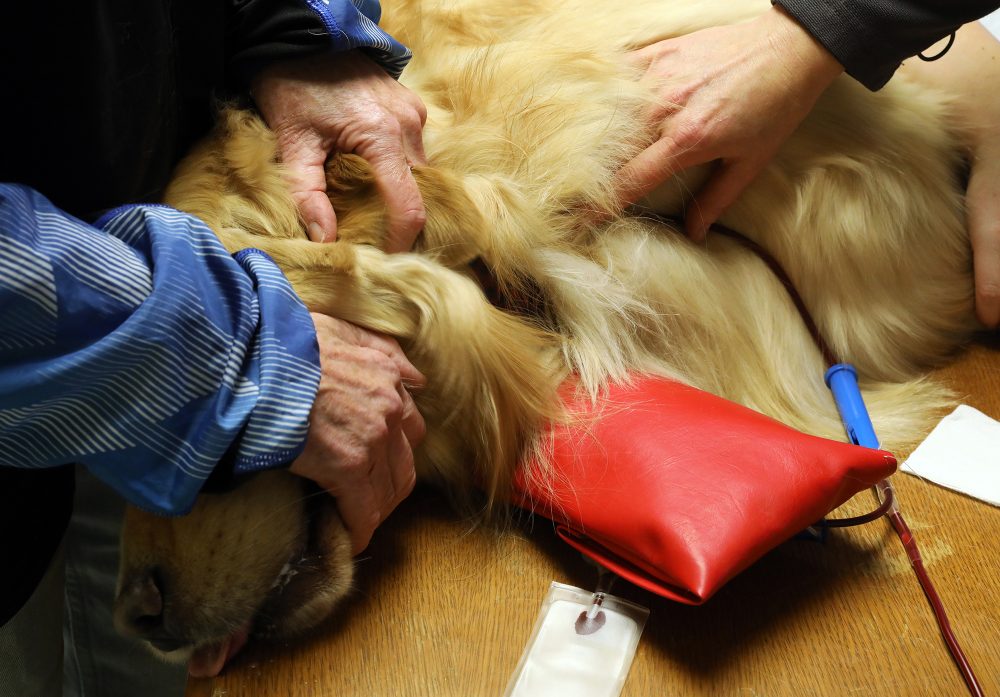
BELLEVILLE, Ont. (21/01/19) — Mary Robinson (right), Donor Recruitment Director of the Canadian Animal Blood Bank, draws blood from Jordan at the Foster Park Pet Hospital in Belleville. Photo by TaeHyeong Kim
Pets can also give at
blood donor clinics for animals
By TaeHyeong Kim
Your lovely dog can help other dogs that
might be sick. For dogs that are sick or
injured and need blood, there are animal
blood donor clinics to help those pets in
need.
“(We do it) to help some other dogs.
It’s a good idea. Somebody would donate
their dog’s blood for my dog. Why not
donate blood for somebody else?” says Jill
Baker, the owner of a three-year-old golden
retriever named Jordan who donated
his blood for a second time on Monday.
Like a person, blood is needed when
a dog or cat is sick or in the surgery because
of some injury or health problem.
The necessary blood is covered by blood
donations. There are dogs that donate
blood regularly for other pets that need
help across Canada.
A local animal blood bank drive event
was held at Foster Park Pet Animal Hospital
in Belleville on the afternoon of Jan.
21. The clinic was scheduled from 12 p.m.
to 3 p.m. with appointments. This event
was held in co-operation with the Canadian
Animal Blood Bank, a non-profit organization
dedicated to supplying blood
products to Canadian veterinarians.
The first dog to donate blood on Monday
was Silas, whose owner is Demera
Hunter. She is a staff member of the hospital
that provided the venue for the animal
blood bank drive event.
“I think it’s really important especially
working in this industry, knowing if a
dog needs it, then it’s available for them.
Because, a lot of times go through fast in
emergency. So, there is not a lot of time to
find a donor. So, a blood bank does really
good work,” said Hunter.
Mary Robinson, who arrived in the
hospital in advance, did not take long to
get the tools ready for blood collection.
She is a donor recruitment director of
CABB, and collected blood directly at the
local animal hospital.
A big table was set for a dog to lie down
on it, and a red pillow was put down for a
dog. Beside the table, there was a medical
plastic collection bag to put the blood in.
Documents checking for blood type and
protein content, and treats for the dogs
were set on the other small table.
Silas donated his blood twice on Monday.
Robinson took a picture of Silas, then
uploaded the photo on Instagram to show
what dogs have donated, and to recruit
more blood donors.
Prior to the actual blood donation,
blood samples were collected to confirm
health status like protein concentration
and blood type. Robinson checked the
name of dog, how old he was, how much
he weighed, what vaccine he has had,
what time he ate breakfast in the morning,
and got a signature from the owners
consenting to the blood donation.
Not all dogs can donate blood. A dog
must meet several requirements.
“There’s a bit of a minimum weight requirement.
So, the dogs must be a minimum
of 25 kilograms, and up to date on
vaccinations. They have to be healthy
because certain diseases and medications
can be derived from donating temporarily
or permanently. They may have to be one
year to eight years to start donating. And
they have to have a really good temperament,”
said Robinson.
The procedure for drawing blood is the
same as human blood collection. After putting
the end of the hose connected to the
bag, the sterilized needle is inserted into the
neck vein of the dog. The red blood slowly
flows into the bag along the hose.
While collecting blood, the dog’s owner,
Demera Hunter, kept petting Silas, and
Robinson continued to compliment him
saying “Good boy” to prevent Silas from
more stressed. In less than 10 minutes,
the bag of 450 millilitres was filled with
red blood.
Robinson pulled the needle out of Silas’s
neck and applied pressure to stop the
bleeding.
Then she fed Silas a treat. Soon after
wrapping some medical tape on his neck
and taking a commemorative photo, Silas
was able to complete blood donation
safely.
Donated blood is separated with the red
blood cells and plasma, and sent to the satellite
office of the CABB, where distribute the
products to veterinaries across the nation.
“It makes sure that we have enough
blood products to support the veterinary
community nationally. We currently ship
anywhere from 60 to 80 units of blood
product a week. So that shows how much
what we do need every week,” Robinson
said.
After donating the blood, it takes three
months to return to their original state,
including red blood cells. So a dog can
donate again after three months.
The demand for dog blood continues
to increase, so the CABB needs a lot of
dogs to donate their blood. The organization
continues to promote blood donation
from dogs to their owners.
Ten per cent off:
What you need to know about education cuts
By Andrej Ivanov
A 10 per cent tuition cut means approximately
$300 in savings a year for college
students and about $700 annually for
university students.
However, these cuts come with several
cuts to the Ontario Student Assistance
Program, or OSAP, and some major
changes to ancillary fees.
According to the media release outlining
the tuition cuts, the change in ancillary
fees would allow students to choose
“which student fees they want to pay and
how that money will be allocated. Fees
for essential campus health and safety
initiatives will continue to be mandatory.”
These fees pay for many resources that
the college provides, including clubs and
hosting social events, the campus radio
station, athletics and campus recreation.
Furthermore, ancillary fees fund many
other student services, such as computer
labs or the Shark Tank. This would also
cause some problems in that the amount
allotted to different groups will likely
change from semester to semester. The
funding would be inconsistent and the
various groups at colleges and universities
would have no way of planning projects
and budgets.
The biggest changes, however, will be
coming to OSAP. The change causing
the most heated debate surrounds the
removal of the six-month grace period
to start repaying student loans.
This means that, although students
don’t have to pay back their debt immediately,
the interest rate will start
growing from the moment the student
graduates. Roughly calculated, this
would add, on a debt of around $40,000,
an additional $1,200 to pay back. This
would later accrue and increase with interest
rates.
Another change would be to the
grant-to-loan ratio to a “minimum of
50 per cent loan for students in secondentry
programs.”
This would mean that low-income
students would not be able to receive free
tuition covered by the OSAP program. It
would mean that low-income students
would receive loans that they would have
to repay. However, the Ford government
will “ensure that 82 per cent of grants”
will be allotted to students whose family
income is under $50,000, according to
their press release.
The Ford government also lowered
the threshold for the total amount of income
a family has to make to qualify for
OSAP. With the previous government,
the total income was at $175,000 and
that has now been lowered to $140,000.
This means that students who are not
supported by their families with incomes
above $140,000 may not be able to access
OSAP.
Overall, the program offers a 10 per
cent tuition cut, but it accrues student
debt and makes postsecondary education
harder to access for low-income applicants.

TORONTO, Ont. (19/01/18) Ð Adelaida Ortega stands at the front of a crowd holding a sign which reads “I march for you” during the third annual Women March On opening ceremonies in Toronto. Hundreds gathered in Nathan Phillips Square before marching together to Queens Park. Photo by Sasha Sefter
Women March On
By Natasha MacDonald
From pink pussy hats and colourful signs to
rainbow pride flags, colour filled the grey,
snowy sky at a Women’s March Saturday in
downtown Toronto.
The charged atmosphere came from the
strength in numbers and support for the
cause. Marchers said there was a feeling of
empowerment and community that was
evident during the event, and they said they
believe change was in the air.
Hundreds attended and trekked through
the freezing temperatures and snow for
Saturday’s Women’s March in Toronto at
Nathan Phillips Square. This was the third
year for the Women’s
March, which began in
2017 after the Trump inauguration.
The focus of the protest
is for equal rights,
equal pay, health care,
education, consent, safety
for diversity of race,
class, and sexual orientation,
resisting the new
provincial government’s continuous cuts,
and ending gender-based violence.
Some of the many speaker’s included
Toronto Councillor Kristyn Wong-Tam,
Sandy Hudson, a Black Lives Matter activist,
sex-ed activist Rayne Fisher-Quann,
Dawn Maracle, a professional speaker and
organizer in a variety of groups that focus
on the Indigenous community, she is also
from Tyendinaga, as well as equity and
gender-based violence expert Farrah Khan.
The RAW (Raging Asian Women)
drumming group gave a banging performance
in the blistering cold, invoking urgency
for the importance of equal rights,
policy changes and the protesters chanted
back, with a boisterous chant of agreement.
Once it was time for the march, the
drumming and chanting of, ‘Women
united will never be defeated!’ began. With
thousands of all ages flooding the streets,
the marchers followed a route that ended at
Queen’s Park.
“We’ve been feminists all our lives and it’s
important to get out there,” said Paula Bowley,
63. “Things are changing, especially
with the intersectional approach, which is
making a difference.”
“I’m happy to see this kind of activism,”
said Daphne Ballon, 60.
Despite the positives that many saw from
the March in Toronto, there has been some
controversy on what was alleged to be the
original Women’s March leadership’s connection
to anti-semitism. It has been reported
that the co-president of the national
Women’s March, Inc., Tamika Mallory, has
an association with the leader of the Nation
of Islam, Louis Farrakhan.
March on Canada released a statement
to address the concern:
“We, as members of March On Canada,
strongly denounce any individual or
organization who supports the increasingly
hateful rhetoric regarding the Jewish
people. In today’s world, we must celebrate
the diversity of our communities. We must
be firm that our steadfast and unwavering
commitment to inclusion must include our
Jewish sisters, brothers and neighbours.
“It is unacceptable that the leaders of
Women’s March
Incorporated are
normalizing antisemitism
under
the guise of the
progressive movement.
Requests
from fellow activists
asking
Women’s March
Incorporated to
denounce anti-semitism have been met
with silence. In our view, that silence equals
complicity.
“We feel it’s of the utmost importance to
speak out to show our solidarity with Jewish
communities around the world in their
fight against this discrimination.
“March On Canada will not support
women’s movement that allows anti-semitism
to take place at the leadership level
— or any level whatsoever. We welcome all
those who wish to continue the good work
of grassroots feminist organizing in a space
of inclusion and acceptance.”
Despite the alleged negative affiliation,
groups all over the world formed their own
marches, like the one that took place in Toronto.
After the end of the march, people left
their signs on the Queen’s Park statues and
in the bushes of a nearby subway station,
boldly stating that the march may be over,
but the fight for equality didn’t end then
and that there is power in number and purpose.
The Women’s March in Toronto was just
one of the few marches that occurred all
over Canada and in many other countries
where people walked in solidarity with the
Women’s March on Washington.
For a video look on the march, click on
this link:

TORONTO, Ont. (19/01/18) Ð Sandy Hudson founder of the Black Lives Matter presence in Canada rallies a crowd of hundreds gathered in Nathan Phillips Square for the Women March On event in Toronto. The crowd marched in solidarity to Queens Park to bring awareness to the changes needed to build a safer, more inclusive Toronto. Photo by Sasha Sefter

TORONTO, Ont. (19/01/18) – Sandy Hudson founder of the Black Lives Matter presence in Canada rallies a crowd of hundreds gathered in Nathan Phillips Square for the Women March On event in Toronto. The crowd marched in solidarity to Queens Park to bring awareness to the changes needed to build a safer, more inclusive Toronto. Photo by Sasha Sefter

KITCHENER, Ont. – 19/01/2019 – Dr. Umut Barish came to protest the treatment of women in Turkey during the Women’s March on Waterloo Region in Kitchener, Ont. on Jan. 19, 2019. The rally started at Waterloo Square and ended in Kitchener City Hall. The march started in protest of the Donald Trump’s election in 2016, and is now in its third year. Photo by Andrej Ivanov

TORONTO, Ont. (19/01/18) – Dawn Maracle (left) Kristyn Wong-Tam (right) and event organizers lead the Women March On crowd of hundreds from Nathan Phillips Square in to Queens Park in Toronto. Photo by Sasha Sefter
Mohawk speaker opens march with
Land Acknowledgement ceremony
By Sasha Sefter
Local woman Dawn Maracle, of Tyendinaga
Mohawk Territory gave a Land
Acknowledgement statement before the
third annual Women’s March in Toronto
Saturday.
Maracle is Mohawk from Tyendinaga
Mohawk Territory in southern Ontario.
She has worked with Indigenous and
non-non-Indigenous communities for
over 25 years in Canada and overseas on
issues such as women’s rights, Indigenous
education, activism and health and governance.
She has a masters of education
from the Ontario Institute for Studies in
Education at the University of Toronto, a
bachelor of education from Queen’s University,
and bachelor of arts from Trent
University.
Currently, Maracle works as a communication
co-ordinator for Kairos, a group
of 10 churches and religious organizations
working together for ecological justice
and human rights.
Territorial or land acknowledgement
ceremonies are an act of reconciliation
which involve recognizing the traditional
territory of the Indigenous people who
called the land upon which the ceremony
is taking place home. This is a tradition
which dates back centuries for Indigenous
people, however, for many non-
Indigenous Canadians, it may be a fairly
new concept.
Maracle opened her speech by recognizing
the original peoples of the territory,
the Anishinaabeg, the Haudenosaunee,
the Métis, the Wendat, the Chippewa and
the Mississaugas of the Credit.
She then called for a peaceful rally,
stating that residents of Toronto live in
“the dish with one spoon territory.” This
was a treaty signed by the Haudenosaunee
and Anishinaabeg people. The
“dish” represents what is now southern
Ontario, the sentiment of the treaty being
that all people in the territory eat
out of the same “dish” and therefore,
must ensure the health of the land and
the creatures within it, so the “dish” will
never be empty.
Maracle then led the crowd in a thanksgiving
address, which is a tradition of the
Haudenosaunee people in which one sets
the tone of their day, grounding themselves
by giving thanks to the creator and
creation.
The crowd was then asked to take a
moment to think on what it is they are
thankful for, before moving on.
Maracle then brought attention to
Canada falling short on its duties to its Indigenous
people. She specifically cited recent
events in British Columbia in which
Unist’ot’en peoples were forcibly removed
from their homes by the government to
ensure the Coastal Gasoline pipeline project.
Maracle stated that these actions are
directly in opposition to The United Nations
Declaration on the Rights of Indigenous
Peoples of which Canada has signed
on to, with no caveats. Article 10 of this
declaration states the no Indigeneous person
shall be removed from their lands and
territories for any purposes.
Maracle closed her speech by reminding
the crowd and all Canadians that even
though the government’s report on missing
and murdered Indigenous women
and children comes out this year, it is
not enough. Maracle urged the crowd to
pressure the government to do more and
make Canada a safe and prosperous place
for all people.
Local musicians jam at Night Kitchen Too
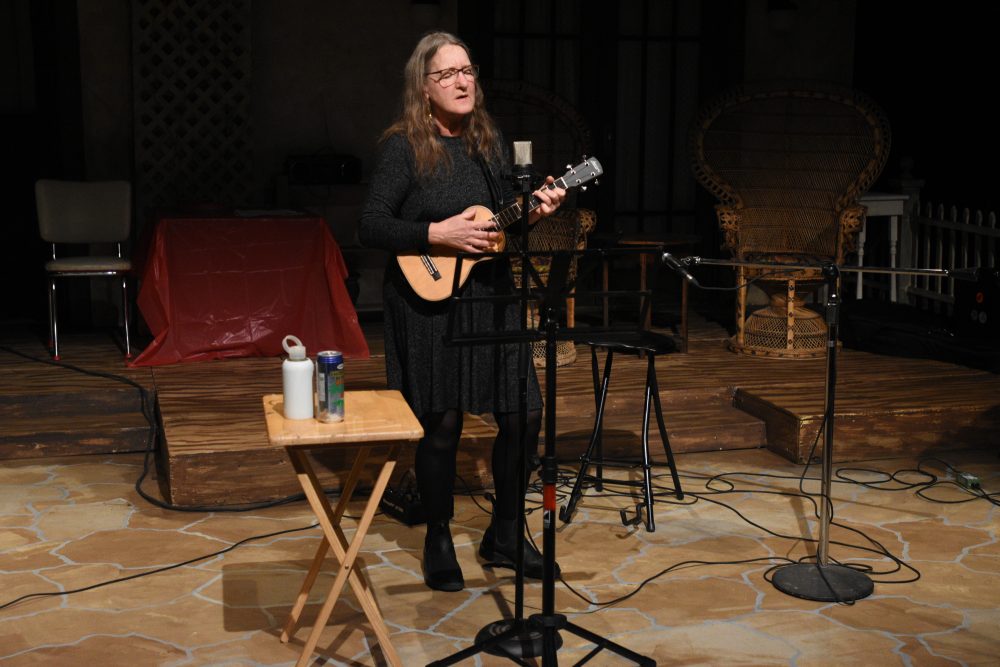
BELLEVILLE Ont. (19/01/2019)– Deb Chatreau plays a song at soundcheck before the show “Night Kitchen Too” starts at the Pinnacle Playhouse in Belleville. The show lets seasoned professionals and upcoming artists of all ages showcase their talents in front of a paying audience. Photo by Amy Walton
Photo by Amy Walton
Belleville’s very own Theatre Guild is in its
sixth consecutive year presenting Night
Kitchen Too, an event that showcases local
musicians and poets of all ages in the Quinte
and surrounding area, giving them a chance
to perform and share their talents in front of
an audience of people.
Joe Callahan, along with Gary Magwood,
and Marvin Tucker, produce the show to develop
a community of musicians who may
not have the opportunity to perform as often
as they may hope.
Callahan, Magwood and Tucker are all
musicians themselves and have been performing
in the shows each year. Callahan also
attributes the show’s continuing success to
hosts/performers, Alexandra Bell and Nathan
Mahaffy, who are also associate producers.
Night Kitchen Too was adapted from a
show presented in Wolfville, Nova Scotia by
Andy Flynn and Ariana Nasr who had a collection
of musical friends that they brought
together to create the first ever Night Kitchen
over 12 years ago.
Coincidentally, a couple who performed
together back at the original Night Kitchen in
Nova Scotia, have recently moved to Belleville
and were pleasantly surprised when they saw
a flyer in a grocery store for the Night Kitchen
Too on Jan. 19. David Marine and Amelia Keating
were eager to be a part the oh-so-familiar
event.
“We’ve only been in the area since the summer,
but we’ve seen a real dedication to community
both in Belleville and in PEC, not just
in music and creative arts but in agriculture,
commerce, tourism, the whole shebang. It’s
how a community is supposed to be.
“So, it’s a huge support for local musicians,
to know that your community supports you
and will even brave a bitter winter night to be
there. And let’s be honest, these are not easy
times for musicians to try to make a living. So,
it’s vital for musicians to have a venue so welcoming
and supportive,” said David Morine
while discussing how he felt about Belleville
adapting the same event and continuing the
tradition.
“I think it’s wonderful to see a second Night
Kitchen starting up. I wish every town in Canada
was fortunate enough to have one!”
On Saturday, 12 performers graced the
stage at the Pinnacle Playhouse, three Centennial
Secondary School students were a part of
that 12, and the youngest was Ridley Pierce,
who was only 10 years old. Night Kitchen Too
has been known to showcase a variety of talented
musicians of all ages and musical styles.
“We’ve now had 60 different feature acts
spanning the six seasons and have never repeated
a feature act ever,” Callahan said. “That
speaks largely to the depth of talent around
here.”
Saturday’s feature act was a pair named
David and Taryn, and the way they came to
be the feature also contributes to the notion
that talented artists can be found everywhere.
Originally the feature performers for the night
were Peter Boag and Christine Atrill. but they
had to cancel last minute due to the unfortunately
bad weather.
Callahan had seen David and Taryn preform
recently at Signal, a bar in Belleville.
After their performance at Signal, Callahan
invited them to come watch Night Kitchen
Too, only because they had filled their lineup
of performers already. At 1 p.m. Saturday, Cahallan
called them up to see if they would fill
in as the feature act only seven hours later in
the day and they graciously accepted.
Night Kitchen Too not only gives up-andcoming
artists a chance to showcase their
talent in front of others. The seasoned professionals
who perform offer mentoring and
advice to any performer who may want it.
Like the original, Night Kitchen Too is a
non-for-profit project, where all proceeds
from the concerts’ admissions are distributed
among the performers. Tickets to the show are
sold for $10 each.
The show is in the heart of Downtown Belleville,
at the Pinnacle Playhouse located at 256
Pinnacle St. This sixth season of performances
still has five upcoming shows if you’re interested
in seeing local talent thrive on stage. At the
end of the show you may dance, sing along, or
simply sit back, close your eyes, and connect
with the music.
If you’re interested in performing at an upcoming
show, Joe Callahan is the talent scout
you should contact. He can be reached at joecallahan48@
gmail.com. For more information
on the event, visit the Night Kitchen Too
Facebook page.
To see more about Night Kitchen Too,
click on this link:
https://vimeo.com/loyalistphotoj/soundcheck
——————————–

Belleville,On (2019/01/19) – The Belleville Curling Club was founded in 1958 and about 300 members are active today. Terry Lynch was the organizer of the recent bonspiel at the club. Photo by Brian Choi
Curling fun for young and old
By Brian Choi
Curling may seem to some people to be
the slowest of all Olympic winter sports.
However, even though it is a game
that seems slow, it is a delicate and
sometimes even tense sport. Curling is
fun for younger and older people, and it
helps everyone to slow down and focus.
Curling originated from a game
played during the Middle Ages on frozen
lakes and rivers in Scotland where
players slid heavy stones onto the ice.
Then, in the 17th and 18th centuries, it
developed into a winter sport centred in
Canada. Since then, it has been selected
as an official event at the 1998 Nagano
Winter Olympics.
There are about 120 curling clubs in
Ontario alone. The season starts around
October and ends in April. A bonspiel
is a tournament or competition between
curling clubs.
Usually, four players in a group throw
two curling rocks each during the
game. The game is played in the form
of a tournament. During the break, they
spray the ice with small drops of water
so it’s ready for the next play.
The Belleville Curling Club was
founded in 1958. There are about 300
members active members and a committee
of 12 members manage the
club.
Bob McPhersonis a curling centre
employee and has been a member of
the committee in the past. McPherson
checks the facilities for defects and repairs
if something goes wrong during
the season.
In fact, the club does much of the
work in the summer off-season, when
they did maintenance such as painting,
installing new floors, and replenishing
new supplies because they ran
out of compressed air. McPherson has
worked at the curling centre for about
20 years.
Membership fees usually depend on
how many games you play, and are usually
between $300 and $500 in total. The
season starts at Thanksgiving or in early
October, and runs until early April.
It usually takes two hours per game,
which means it takes about 15 minutes
per person.
Some bonspiel games are for beginners,
games that take place every Friday
morning, and usually run for one day,
but sometimes for two days. The cost
of entry to the bonspiel game is usually
$25 per member, and the winner of the
game is given a pizza or free meal ticket.
The bonspiel is held in the form of a
tournament,and some of the best winners
have their names inscribed on the
bonspiel trophy.
Terry Lynch was the host of Friday’s
bonspiel game. He works as a volunteer
and said he is very happy to serve
the community. Besides Lynch, seven
to eight people came out to voluntarily
prepare items for the event and serve
food. Lynch has been a member of the
club for about 10 years.
For him, curling is more than just a
sport – it’s a social relationship itself.
He says that through curling, he has
a chance to socialize with neighbours
with the same hobby and to take care
of his health through exercise. Many
companies, organizations, and stores in
Belleville also sponsor the curling club.
Through curling, the club’s members
are creating healthy and social relationships.
Janet Quinn is vice president of the
curling club. She played in Friday’s bonspiel
and attended the event with her
family. She has enjoyed curling for 12
years.
She says the Belleville curling club
brings a sense of community, friendship
and harmony rather than competition.

BELLEVILLE, Ont. (19/01/19) — Rickie Smith (left) and Peyton fish at the `Cops and Kids Ice fishing Derby’ last Saturday. It was held near the Herchimer boat launch in Belleville. Photo by TaeHyeong Kim
Cops and kids come out for frosty fun
at weekend ice fishing derby in Belleville
By TaeHyeong Kim
The Cops and Kids Ice Fishing Derby
event was held Saturday on the
shores of Lake Ontario on one of
the coldest days so far this year.
The event, now in its third year,
went from 9 a.m. to 12 p.m. at Herchimer
Boat Launch in Belleville.
“We do it because we want a partnership
with kids in the community.
So we do this as a way to make
a friendship through fishing,” said
Const. Patrick Comeau of the Belleville
Police Service.
For this event, members of the
police service provided and prepared
fishing gear and bait and
made holes in the ice for fishing.
On the shores of the lake there was
a tent to get out of the cold. Chili,
donuts, hot chocolate, coffee and
Timbits were also available to help
keep everyone warm. A free toque
was given to the first 100 children
at the ice fishing derby. The ambulance
service also attended in case
of any emergency.
Snow was piled up on the surface
of the Bay of Quinte, which was
frozen near the Herchimer pier.
Some nearby clear ice was over 30
centimetres thick, so there was no
need for any concerns about ice
safety.
“The hardest thing for today was
weather and making sure that everyone
was safe,” Comeau said.
In the southern Ontario region,
there were extreme cold warnings.
Even close to noon, the cold still
exceeded minus 18 degrees C. Ice
holes drilled for ice fishing were
frozen over again; the bait was frozen,
and the fishing lines were frozen.
However, the cold was not a big
problem for the children who were
catching fish.
“It’s so cold, but it’s good,”
young participant Avery Kelleher
said, while laughing brightly as he
showed off the fish he caught in the
derby.
“We had over 130 kids, probably
got 200 people all together,” Comeau
said.
Many participants pledged to attend
next year’s derby already.
Today’s event was short and sweet
and it was very, very cold, but I
continue and do it every year,” said
Gordon Mclean who participated
with his son, Kieren.

Belleville, Ont – 22/01/19 – ephen Zammitti is a Loyalist staff member who is also part of the Magic Wheelchair club. The Magic Wheelchair is a club at loyalist that creates costumes for children in wheelchairs. Photo by Debbie MacNevin
Magic of making costumes
for children in wheelchairs
By Debbie MacNevin
Halloween is one of the biggest nights of
the year for most young children. They
rush home from school full of excitement
and get into their costumes.
Soon they go from a regular kid to whatever
they want to be. That could be anything
from a powerful super-hero to pretty
princess. Companies all over the world are
making it easier and easier for children to
became anything they want when it comes
to costumes. However, for some children,
it isn’t as easy as slipping on a cool costume
to go out. For those children, it takes a
little more effort.
The non-profit organization, Magic
Wheelchair, began in 2015 in Oregon in
the United States. A father whose children
were in wheelchairs talked with one
of his children about what they wanted to
be for Halloween. When one of them, who
is in a wheelchair, said he wanted to be a
pirate, it gave the father the idea to create
a costume. He made a pirate ship for his
child’s costume. That’s how it began. From
that moment on, the organization has gone
nationwide in the United States, creating
everything from Halloween costumes to
comic convention costumes.
Loyalist College is the first college and
the first in Canada to be inspired to create
a club with this project. The Magic Wheelchair
Club here at a Loyalist creates costumes
for local children in wheelchairs using
the skills and knowledge they have here
at the college. Last year the club created a
costume for a boy named Brady Wilson.
Wilson, an 11-year-old boy who is nonverbal
and colour-blind. One colour that
really stands out to Brady is the colour red.
After awhile, his family noticed that one
thing that Brady really seems to enjoy most
was The Wiggles and he loved the big red
car. So, it was the perfect idea his costume.
“When we took Brady out in this, it was awesome
to see the response from people that
didn’t realize that this child was disabled,
let alone in a wheelchair,” said Stephen
Zammitti, who is a Loyalist staff member.
“They just thought it was an awesome costume.
That he’s rolling around in this car.”
The big red car was constructed out of
foam. The outer shell is hard and resembles
much of an actual car. The Loyalist
club is interested in taking this farther than
they have. Instead of simply creating costumes
for children to wear on Halloween,
they want to allow the children to be able
to use their costumes for things such as going
to a comic convention.
The idea to bring this to Loyalist came
from the founder of the club, Cameron
McLean. McLean is a Loyalist alumni.
While reading an article about the original
organization, McLean had the idea to
bring this idea to Loyalist.
McLean, along with Zammitti, thought
that Loyalist could really be the cornerstone
to making this more of a reality. After
the costume was created, Zammitti and
McLean joined Wilson and his family on
Halloween. Both walked with Wilson, side
by side and were dressed as Sharkie and
Lanny, Loyalist’s mascots.
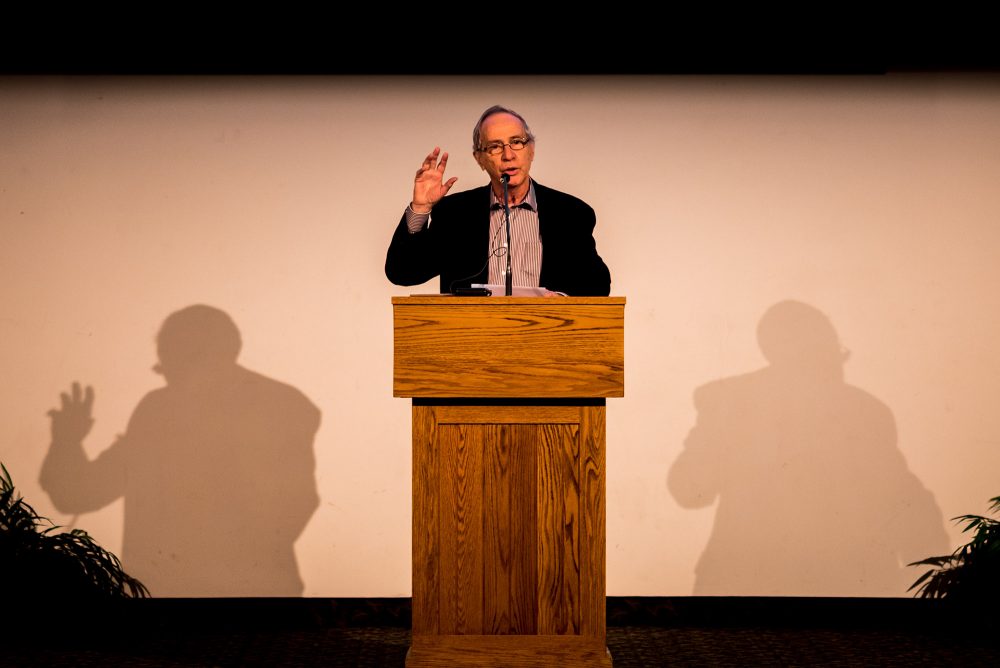
BELLEVILLE, On. (15/01/19) Richard Hughes, President of the Hastings County Historical Society talks at the “History Of Tombstones” event conducted at Maranatha Church, Belleville. Since Hughes’s post in the council, the HCHS has won awards from The Archive Association of Ontario, and installation of historical plaques throughout downtown Belleville. Photo by Matthew Syriac Elias
Fascinating history of tombstones in Belleville
By Matthew Syriac Elias
The dead and buried of Belleville didn’t go
down without stories to tell through their
graveyards and headstones.
The Hastings County Historical
Society, or HCHS, kicked off the new
year with a public presentation called
“The History of Tombstones” on Jan.
15. The event was held at the Maranatha
Christian Reformed Church on
College Street in Belleville.
Richard Hughes, president of the
historical society co-ordinated and
kickstarted the event for the night.
Less than a year ago, the Archives
Association of Ontario awarded the
HCHS for its prominent role in the
creation of new community archives
in Belleville, under the leadership of
Hughes.
Downtown Belleville’s first of four
historical plaques were also unveiled
last year, which were inaugurated by
then Mayor Taso Christopher.
Minus One Hundred, a talk by historical
society board member Trevor
Parsons, gave an insight into what was
going on in the Belleville area exactly
100 years ago. Parsons cited letters,
flyers, and even news headlines from
1919 issues of the Belleville Intelligencer.
They included military recruiting
ads, a letter between a mother
and her son in the military, weekly
shopping deals and upcoming movie
posters.
“A speech in Belleville by Robert
Borden, former Prime Minister at the
time, and now the leader of the opposition,
met with a bunch of Liberals
and did something that our prime
ministers tend to do now. He issued a
great apology,” said Parsons, referring
to an article in the Intelligencer.
The main presentation was given
by Gary Foster. Foster is an expert
on cemeteries and is a Belleville resident
well-known for his expertise in
the field, knowledge on the history
of tombstones, and the Belleville area
itself. He frequently conducts presentations
and history classes for the historical
society, and the public.
A graduate of the archaeology program
from Trent University, Foster
worked as an archaeologist in Parks
Canada in Cornwall until 1986, when
he moved to Belleville. He currently
serves as the president of Campbell
Monument, a cemetery headstone and
monument company. Campbell Monument
has a history of over a century,
being locally owned since 1909, and
has been an employee-owned company
since 1984.
Foster’s talk and presentation covered
a wide variety of information
about the history, trends and evolution
of the tomb, and tombstone designs.
He emphasised on how the history
of Ontario, and the 20th century
overall in North America and Europe
inspired the designs and trends of
monument building throughout.
“Factors of this evolution included
economic state, social cultural values,
transportation system and migration
patterns,” said Foster. “The
cemeteries of the past teach us of the
times they were built in, providing
more information than just names
and dates.”
Foster mentioned a few historical
cemetery monuments found in Belleville
too, mentioning lesser known
facts about their design.
Foster also touched on how many
tombstones from the past have humorous
lines engraved on them sometimes.
He mentioned a headstone
from 1900 that he had seen, which
reads:
“Here lays Doctor Bill, He took one
of his own pills, He swore it wouldn’t
kill, But he’s lying awful still.”
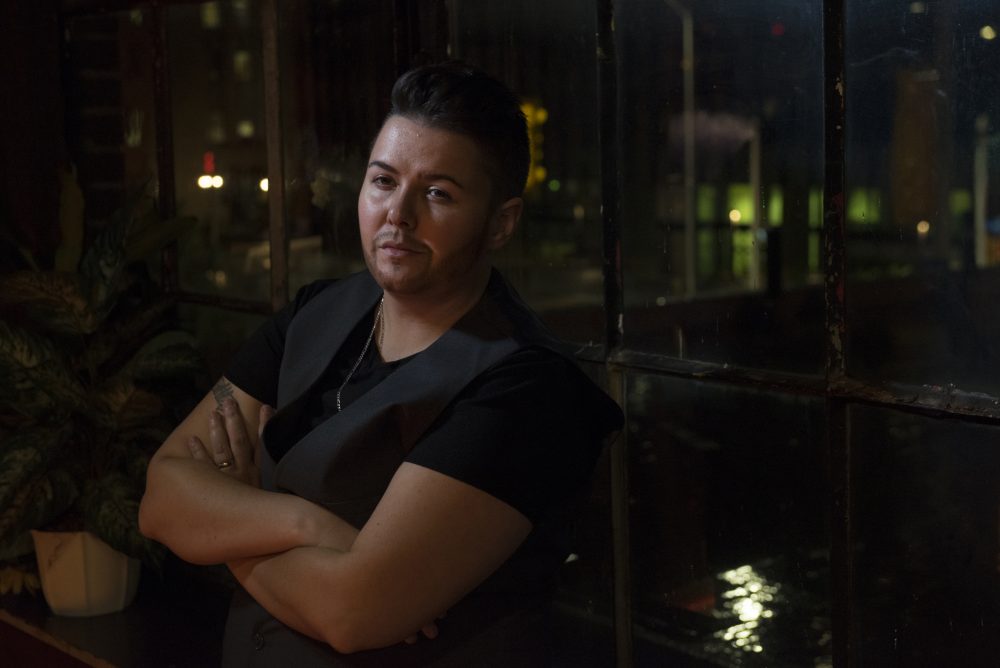
OTTAWA, Ont. (28/09/18) — A night to remember at the Glue Pot Pub when it’s first drag king, Karter Banger, stepped on stage. It was an evening full of fun from comedy by the host and burlesque by the Capital Tease Burlesque group. Banger, the Ottawa-based drag king, poses after a positively received first appearance at the pub. Photo by Natasha MacDonald
Karter Banger brings it to the main stage
By Natasha MacDonald
Karter Banger has been performing as a
drag king for just shy of a decade. Banger
grew up in the small town of Osgoode,
eventually making it to Ottawa, which is
where it all started.
After making the move, the experiment
with performing and impersonating a
male persona began. There was a comfort
and confidence that grew within all those
years of being a drag king performer.
The world has become familiar with drag
queens, who are mostly (but not limited to)
gay men performing as women. The drag
king scene is less well-known and is women,
trans or non-binary people of various sexual
orientations performing as men.
Banger started off solo and then shortly
after, moved to be a part of Canada’s Capital
Kings Troupe. One of five members, he
was also named Mr. Capital Pride 2016.
Being one of the five kings of Canada’s
Capital King’s troupe, Banger is known for
being that charming “bro” that exudes a
confident character. And that was just the
beginning.
Karter Banger is the confident, comedic,
curator of character, while Kim Stewart,
the actual person behind the drag king, is
one that is not seen right off the bat. Although
physically embodied in the same
human, this is what drag is about. Drag
does exactly that. It drags out a part of
someone and further acts as an outlet.
Now, specifically with the smaller or
lesser known scene of the Kings, they’re
still a mighty force in the queer community
when it comes to identity. Of course,
gender-bending is not only visible in that
community, but it’s where it often makes
its first appearance.
A drag king is a gender-inclusive performance
take of the male/masculine embodiment.
It means a person who identifies
as female, genderqueer, non-binary,
or trans, outside of drag, and identifies
as male, using he/him pronouns while in
drag, or “in face.” It’s playing off stereotypes
of masculine or male-associated characteristics
to create an enticing, provocative and
entertaining performance.
Most of the drag king scene is centred
on gay or alternative clubs, as entertainment.
Performance is a big part of drag,
where there can be lipsyncing, dancing
and comedic scenarios played out.
The lines between performer Karter
Banger and real-life Kim Stewart slowly
seeped and mended closer together. The
confident and cool, smooth and slick
Banger on stage, made for a massive
change in the everyday life of Kim Stewart.
At the beginning, Banger was introduced
by Stewart and today, you’ll likely be meeting
Karter first, and maybe get a chance to
meet Stewart.
“When I started doing drag, that’s why I
feel like there was such a line at the beginning
because I was actually me. And then
I could be that boy, you know? Whereas
now… I mean, that was almost 10 years ago.
So now, you can call people whatever you
want. You don’t need to be labelled and I feel
like that’s why it meshes so well. There’s no
line anymore. They just overlap each other.
“So, I feel like, since then, I was really
trying to find myself. In my regular life, I
identify as a female, I go by ‘her’ and ‘she’
but I also get that other aspect when I’m in
drag and I’m ‘he’ and I use the male pronouns.
And I’m glad that I have both, you
know.”
Keeping it cool and collected, Banger
exudes a compelling, confident persona.
“My stage persona is very confident.
Karter is this super confident and charming
is what I say. Where my real-life person
is that I’m not as outgoing, I’m more of a
dork, and if I were to be at a club, I’d be
like ‘Yeah, I’m going to snap my fingers,’
and Karter would definitely never do that.
That’s not cool.”
Having recently married burlesque
dancer, Koston Kreme, the two started
off performing together in shows here
and there, before discovering a liking for
one another. A drag king and a burlesque
dancer. Sounds like there is a new fairytale
for some to look up to growing up.
Burlesque performer Vixen Vega’s most
significant memory of Banger was the
wedding day.
“Standing in, watching him marry
the love of his life. That one pretty much
makes up for all greaseball pick-up lines
I’ve had to endure!”
Both being supportive of one another
only adds to the exuding and endearing
persona of the Karter Banger band wagon.
From upbeat dance moves and much
of the boy-band inspired tunes, Banger is
bringing it to the stage with a witty comeback
or a stand-up specialty.
Vega sums up the high-top sneaker
wearing Karter Banger this way:
“Karter is the charming bad boy your
mom always warned you about. He has a
way of wrapping his own brand of charisma
around all the dirtiest, greaseball qualities of
a man. It’s like being served Cheez Whiz at
a fancy dinner party, but then offered a vintage
bottle of merlot. It only takes one glass
to overlook the horrid snack.”
It can be far from easy talking in front
of people, but not for Banger. The thrill of
performing on stage is embedded in the
ability to appeal to everyone in the audience.
“Much like the wine, after witnessing
one Karter Banger performance, the audience
is truly captivated,” Vega says. “In the
blink of an eye, you realize this wily dirtbag
has hypnotized you into becoming the
guiltiest of your guilty pleasures and the
Cheez was the perfect appetizer.”
One of Banger’s most memorable moments
performing was during a troupe
show, and the tear away pants the members
of the drag king group were wearing
to perform in.
“The Toronto Burlesque Festival, we got
in…and we were the only drag kings in
that show.
“So, when we were backstage, I told the
guys, ‘So, if your pants start ripping, literally
just rip them off and throw them and
keep going.’
“So, we started doing the dance and David’s
pants start going. So, he takes them,
rips them. We’re still dancing and then
Jack’s pants start ripping, so, he pulls them
off, and then we are doing the chorus and
the second chorus.”
Wait for it…
“And I’m in the front row, right in the
middle, and we’re going and I could feel
my pants start ripping. And right after the
chorus, after we were supposed to just rip
them off the pants, I was like, ‘I just have
to keep going.’ And threw it and was like,
‘Whatever,’ and then when it came to the
point to rip our pants, only three of us had
them. They did it and we did the motion,
and afterwards we were like, ‘Dammit,
these pants.’”
But the audience was far from complaining
and were gushing over it the
whole time.
From growing up in the small farm
town to becoming Mr. Capital Pride,
there’s never a way to know what direction
life can take you. For Karter Banger, the
simmering stud muffin, this was exactly
what happened.
Although drag is a performance, that
doesn’t mean it doesn’t find its way into
everyday life.
Although the song favourite Filthy by
Justin Timberlake may be a fitting flirtation
of his bad behaviour, Banger enjoys a
day off, just like the rest.
“So, a perfect day off would be my mom,
would have my dog, so I wouldn’t have to
wake up early, sleeping in and doing nothing.
Relaxing, watching some mindless
TV, ordering in, have a bag of chips (Plain
Ruffles), sweatpants all day. Regular me.”
Today, the lines have blurred for Karter
Banger and have allowed for the confident,
charming and charismatic undertones to
amalgamate with Kim Stewart.
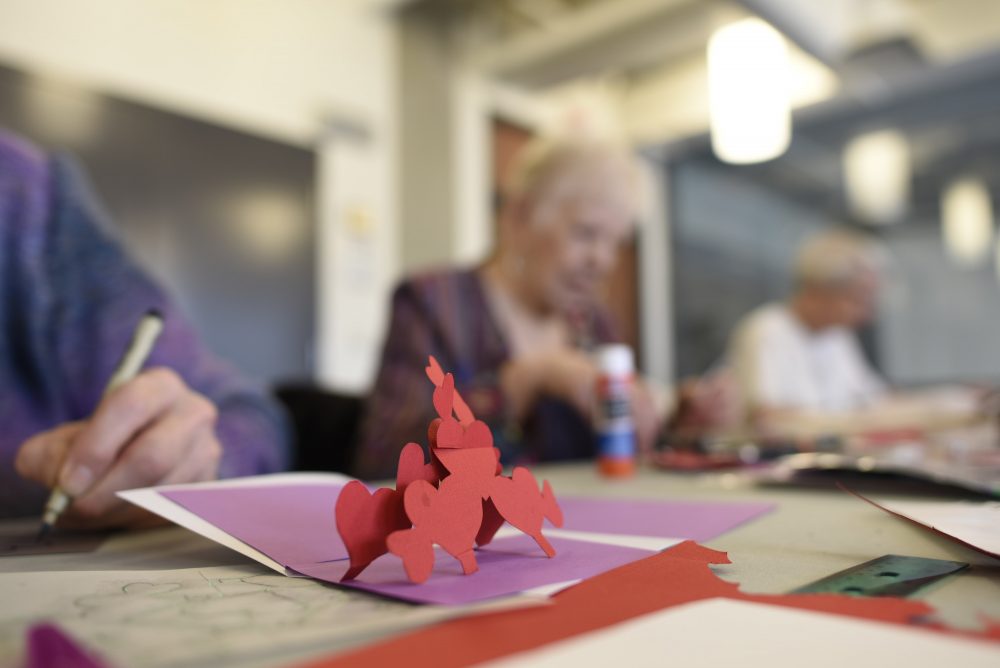
BELLEVILLE, Ont. (18/01/19) – The Doodle Group hosted by Marita Langlois held a monthly event at the Parrot Gallery in the Belleville Public Library Jan. 18. This month, they were working on greeting cards with red hearts that pop up when they open.. Photo by Mari Hiramoto
Doodlers meet up monthly for some fun
By Mari Hiramoto
Doodle Group held a monthly meet
up on Jan. 18 from 10 a.m. to noon
at the Parrott Gallery in the Belleville
Public Library. Diana Bingham demonstrated
how to make a pop-up card
to the other eight members.
“This is a great little addition to
the doodling because we do a lot of
greeting cards,” said Marita Langlois,
the organizer of the Doodle Group.
They usually have eight to 14
people that show up to the meet up.
Bingham and Langlois brought most
of the supplies for the Friday’s session.
Langlois said she has too many
supplies at home so she decided to
share it with the group members.
There is no membership fees, as
the library provides them a room for
free. Most of the members are female
in their 30’s to 60’s.
“Every once in a while we get a
male member that comes in but I
haven’t seen one yet that lasted more
than one session,” Langlois chuckled.
This group was started a few years
ago by Laurie Sinclair and Racheal
Como. They were going to cancel
the group because there was nobody
leading it after both of them had to
leave.
Langlois volunteered to become
a new organizer and they have been
trying different types of artwork every
month.
“Usually we are doodling but we’d
like to change it up every once in a
while,” Langlois said.
Last month, they created Christmas
cards with “negative space letters”
where you leave the space for the letters
as blank and doodle all around it.
The greeting cards they were creating
this time have a couple of red hearts
that pop up when it’s opened.
They also have a Facebook group
where members can share their artwork
to each other. Langlois usually
takes pictures at the end of session
posts them to the page. For more information
about the Doodle Group,
visit their Facebook page (www.facebook.
com/groups/thedoodlegroup/)
or call Belleville Public Library (613-
968-6731 ext. 2040). Their next meet
up is on Feb. 21 from 10 a.m.

BELLEVILLE, ONT (13/01/19) Two people skate over the frozen Bay of Quinte at Meyers Pier while the sun sets in Belleville, Ont. on Jan. 13, 2019. Photo by Alex Filipe

Belleville,On (2019/01/22) – A car was left in an accident on the side of the road of Moira street in Belleville, Ont. on Jan. 22, 2019. Police said that the car was simply abandoned in the ditch. Photo by Brian Choi

BELLEVILLE, Ont. (23/01/19) – Coordinator of Wellness Programming for Loyalist College Ryan Stoness lounges on a beanbag chair with his team of Wellness Ambassadors in the newly created “Wellness Loft” inside Loyalist College. Photo by Sasha Sefter
College launches Wellness Loft
By Sasha Sefter
Loyalist College has opened a new space
for students and staff to unwind and
destress from the demands of postsecondary
life.
A recent National Health Assessment
completed in 2016 found that 44 per
cent of the 43,780 Canadian students
surveyed felt so depressed over the previous
year that it was difficult to function.
Colleges and universities across the
nation have heard the call to action, with
many creating safe spaces for students to
destress and creating programs designed
to improve the mental health of their
participants.
Loyalist is working hard to understand
the needs of its students and staff
with to foster effective mental health services
and provide appropriate wellness
programming. Two years ago, the college
identified the need create programs and
solutions to positively affect waning student
mental health with a focus on longterm
student wellness.
Ryan Stoness was hired as the coordinator
of wellness programming at
Loyalist and is responsible for increasing
a culture of health and wellness at the
college.
“Wellness is for everybody, all of the
time. We want to eliminate as many barriers
as possible and make our programming
accessible, valuable and fun,” said
Stoness of his team’s mission.
Stoness said he feels this is best accomplished
by focusing on two major
areas, developing programs for proactive
wellness and putting an emphasis on student
engagement and leadership. Stoness
is not only involved in creating programs
and positions for students but also developing
policy and strategy that ensure the
college has the wellness of its students in
mind at all times.
Asked who may benefit from the services
offered by the college Stoness siad,
“Everybody needs to work on their
wellness. We can all benefit from getting
a little more exercise, a little more sleep,
a little more time to relax. Those are all
things that benefit us when we’re at our
best or when we’re at our worst.”
On Jan. 23, Loyalist launched its latest
student wellness effort, a barrier-free
safe space called the Wellness Loft. The
concept of the loft is that it will be a student-
led space where the colleges wellness
ambassador leadership team will
design and put into place programming
aimed at improving students’ mental
health.
The loft itself is furnished with comfortable
couches, bean bag chairs, and
yoga mats. It is also stocked with healthy
snacks and tea should a student need
to replenish some energy in-between
classes.
The space is open to students weekdays
9 a.m. to 5 p.m. and will run a variety
of programs including mental health
seminars, relaxation nights, yoga and
guided meditation classes.
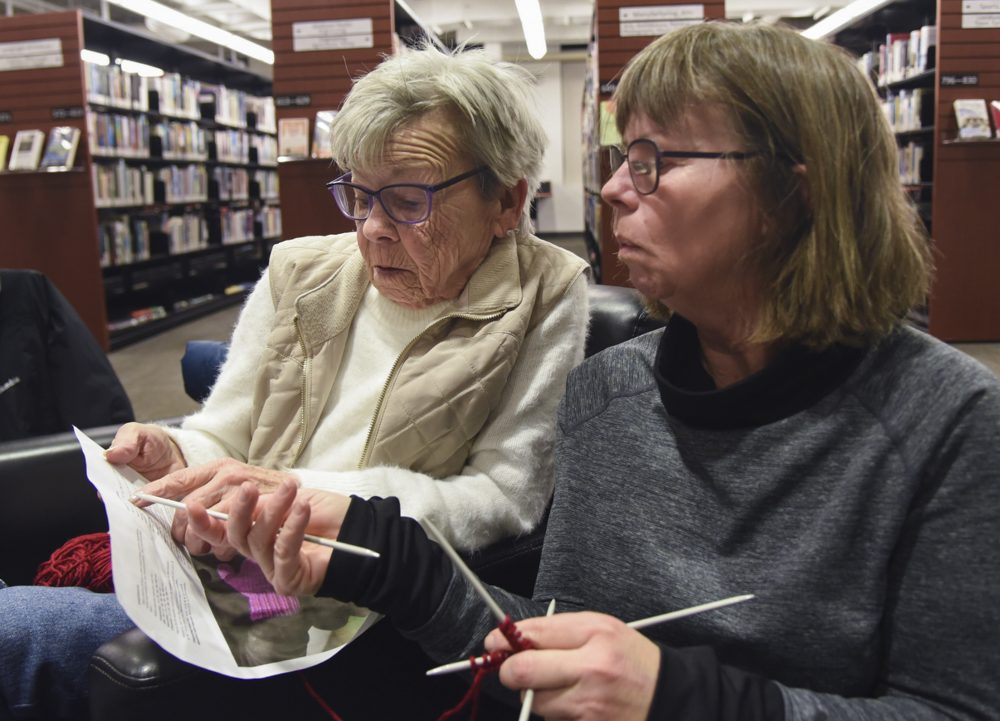
Belleville,On (2019/01/22) – Lolly Carr came with her mother, Ellen Carr, to the Knitterati knitting club at the Belleville Public Library. Ellen taught her daughter how to knit when Lolly was
young. A knitting club is held every two weeks on the second floor of the Belleville Library.
Knit One, Purl Two
Photos and Story by Brian Choi
In historic times, before the clothing industry was developed,
winter clothes were mostly made from the hands of mothers.
Times may have changed, but some things, like making
clothes by hand, have still survived.
Knitterati is a small knitting club held at the Belleville public
library. The group meets at 5:30 p.m every second Tuesday
on the second floor of the library. Although there are about
10 members, they usually get about seven to eight members
attending.
Annette Buckley is one of the members of Knitterati. She
was an immigrant from England to Canada 40 years ago. She
is 66 years old. When she was young, she learned to knit from
her grandmother and this small knitting helps her keeping
her life well. She believes that knitting helped her raise two
children well. Her husband died at a young age and she has
been with her hard-hearted people.
During the Christmas season, she knits and donates children’s
clothes for those in need. She knits with yarn provided
from Belleville Fire Department and gives it back to fire hall
for them to donate during the holiday season.
A small baby sweater takes Buckley about two days to
make, and a large sweater takes about two weeks to make.
Susan Mcdonald started to knit when she was eight years
old. After more than 50 years of knitting, she has improved
enough to make socks without using a pattern.
The charm of knitting is that it is a peaceful and meditative
pastime. The members of the local knitting club all agreed
that they experienced the peace and relaxation that comes
from knitting.
The members said they each donate products they make
knitting to their own churches, local fire stations, and donations
to their neighbors.
Lolly Carr comes to the knitting group with her mother
Ellen Carr. Lolly Carr has been knitting for 25 years. She still
does knitting for one to two hours every day.
For her, knitting is relaxation itself. She learned from her
mother when she was young, but now she teaches her mother
some knitting techniques. It all comes from continuous practice.
With her long experience knitting, she now has an easy
grasp of difficult patterns. She is donating her knitted products
to the fire department at the end of the year, with Buckley.
This knitting club hasn’t membership fee so if you want to
be together with them, Just bring your own knitting materials
with you.
The group gathers together freely to share information on
knitting and share life stories. The members told that once
someone get involved in this club, it would become more and
more attractive. Laughter and laughter flowed throughout
the knitting circle.
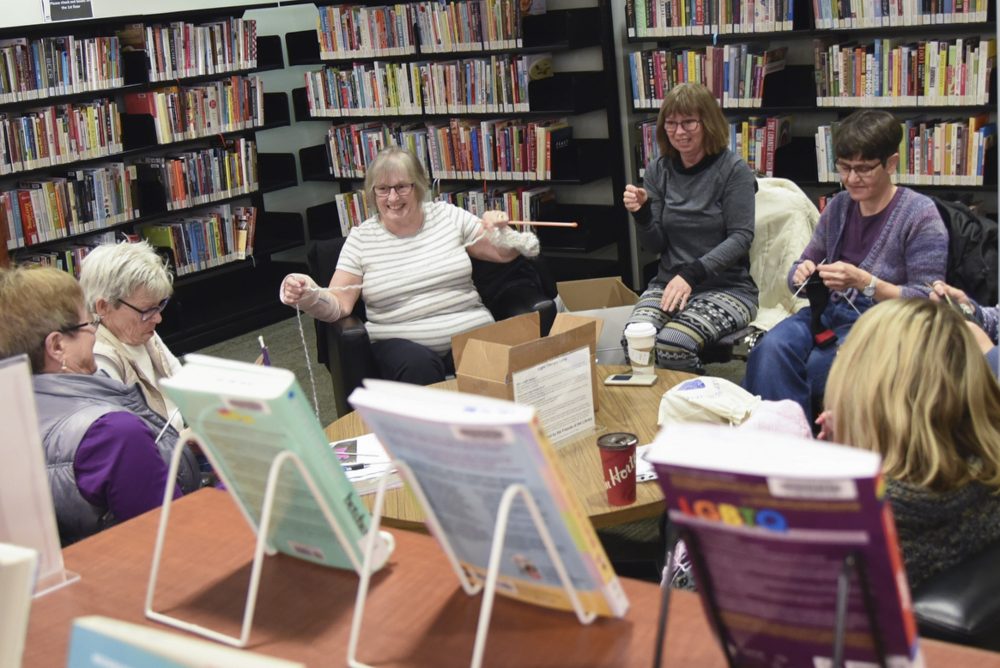
Belleville,On (2019/01/22) – The Knitterati knitting circle gather this week at the Belleville Public Library. The knitting club meets every other week to talk knitting and enjoy each other’s company.
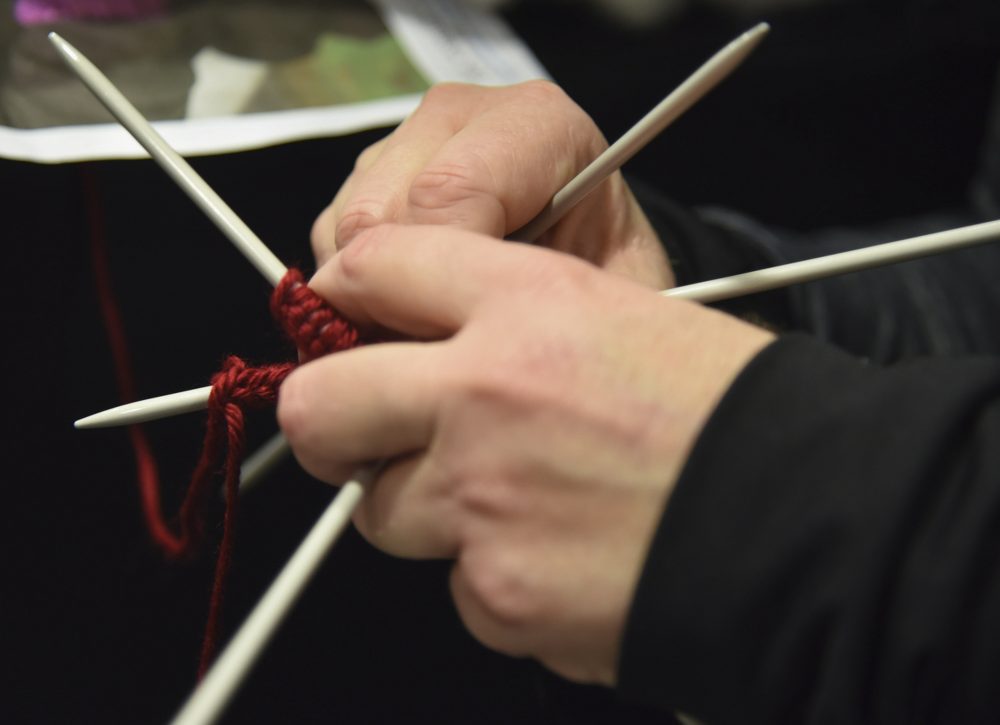
Belleville,On (2019/01/22) – Lolly Carr shows her mother Ellen, how to grip double-pointed knitting needles at the library.
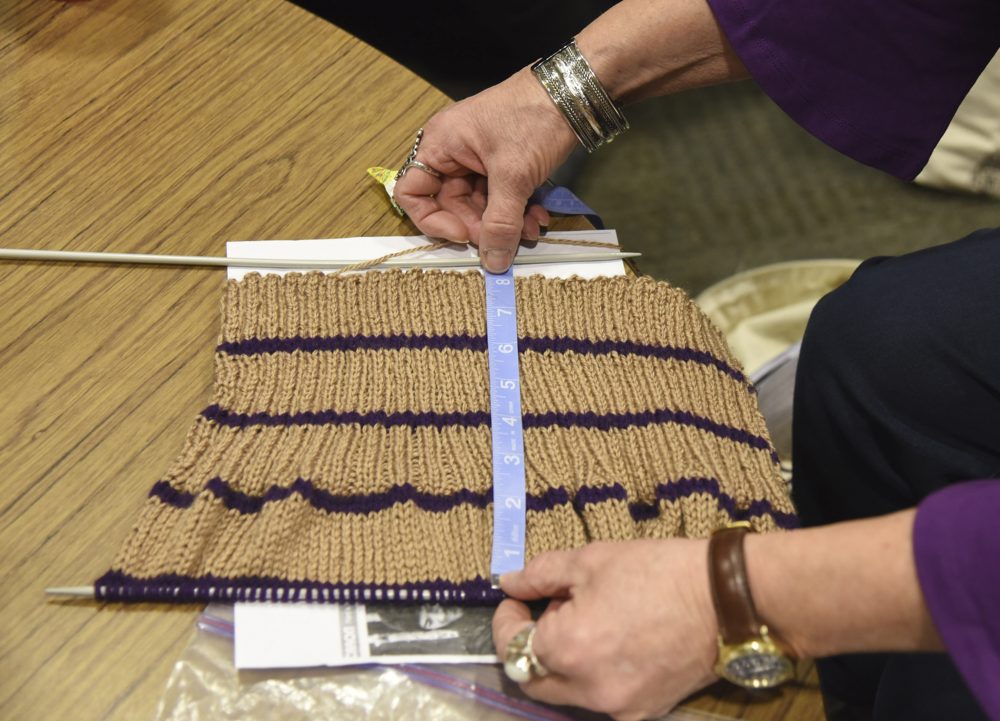
Belleville,On (2019/01/22) – Accuracy is critical in knitting. One participant measures to make sure the size works.
————–
Campus Creativity
Photos and Story by Amy Walton
Everyone has a pasttime, whether it be watching television, reading a book or going for a walk. But you’d be surprised how many people have unique or extensive hobbies right here at Loyalist College residence.
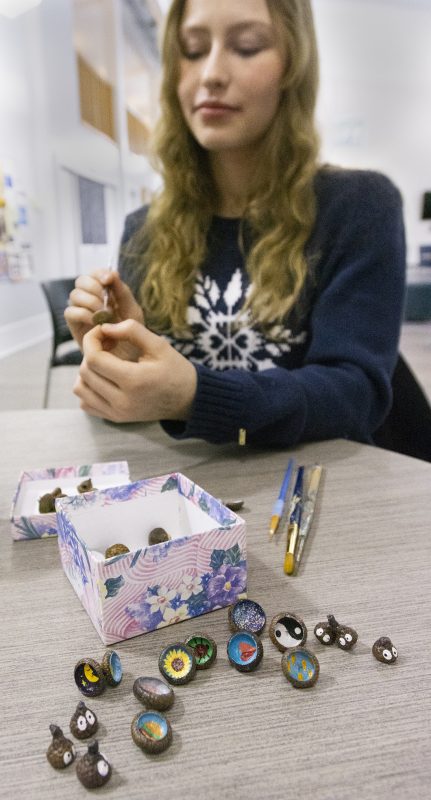
Sonora Plumb
The Acorn Painter
One creative hobby that many have is painting. There are all sorts of types of painting, realistic painting, abstract painting, watercolour, the list goes on.
However, one resident at Loyalist has a unique aspect to her painting. The way she paints is sustainable and eco-friendly.
Sonora Plumb, who is in a manufacturing program at the college, has an interesting passion of painting acorns. She paints tiny, very detailed designs on the inside of the acorn hat. She also paints full acorns and the little nubs that don’t quite grow. She paints tiny eyes on them, making them come to life.
Plumb got inspired to paint acorns after seeing people painting a certain mushroom that grows on trees back when she was living in Moose Factory, Ont. She loved the idea of painting something natural, but she wanted a slightly smaller canvas. She even asked her mom for acorns for Christmas, so her mom collected over a 100 for her to start creating her tiny acorn art.
Back in high school, Plumb would ask the woodshop teachers if she could use the scrap wood to do paintings on too. Anything she can get her hands on that is natural, or otherwise would be thrown out, she will use. She likes to repurpose things and bring them to life with her art.
“I do paint on canvases too, but I don’t like using them and buying them new because I feel conscious about the environmental impact of it. That’s why it’s really comforting to me to be able to get stuff that was going to be thrown out anyways, or natural stuff found in nature,” Plumb says. She is also a part of the Sustainable Loyalist club so she is passionate about the environment.
“I set out an hour or two to paint a couple so I’m not rushed. It’s not like I’m making money off these. it’s more like a calming down or getting in touch with myself sort of thing. It’s like my personal alone time.”
Plumb says her goal is to carve out a specific time each week to something creative.
“I’ve always said to myself that this skill is not important, but it can actually be useful in your life. It’s very calming to just do something that your good at and enjoy.”

Rachel Frederick
The Chef
Most people probably wouldn’t consider cooking to be an outlandish hobby, seeing as we all must do it at some point. It’s quite easy to pop something in the microwave or in the oven, but considerably more difficult to make food by scratch.
Rachel Frederick is a culinary student at Loyalist and lives on the Loyalist residence, where she cooks all homemade food for herself and her roommates. She recently made a spaghetti dinner, completely from scratch.
She has lots of complex gadgets for making her food, one of them being a pasta-rolling machine. Frederick made the dough by scratch, rolled it over and over, stretching it so that she could put it through the machine, making strings of homemade pasta.
Although this method takes much more time than simply cooking already-made pasta, Frederick likes to go the extra mile and prepare all her food herself.
“There is just something about the way I can take a few simple small ingredients and make something that I can be proud of. However, the thing I love most would have to be the smiles on people’s faces when you take the time and effort to make something homemade for them.”
It’s the little things about cooking that bring her great pleasure. We all know home-cooked meals are always the best meals, and her roommates definitely agree.
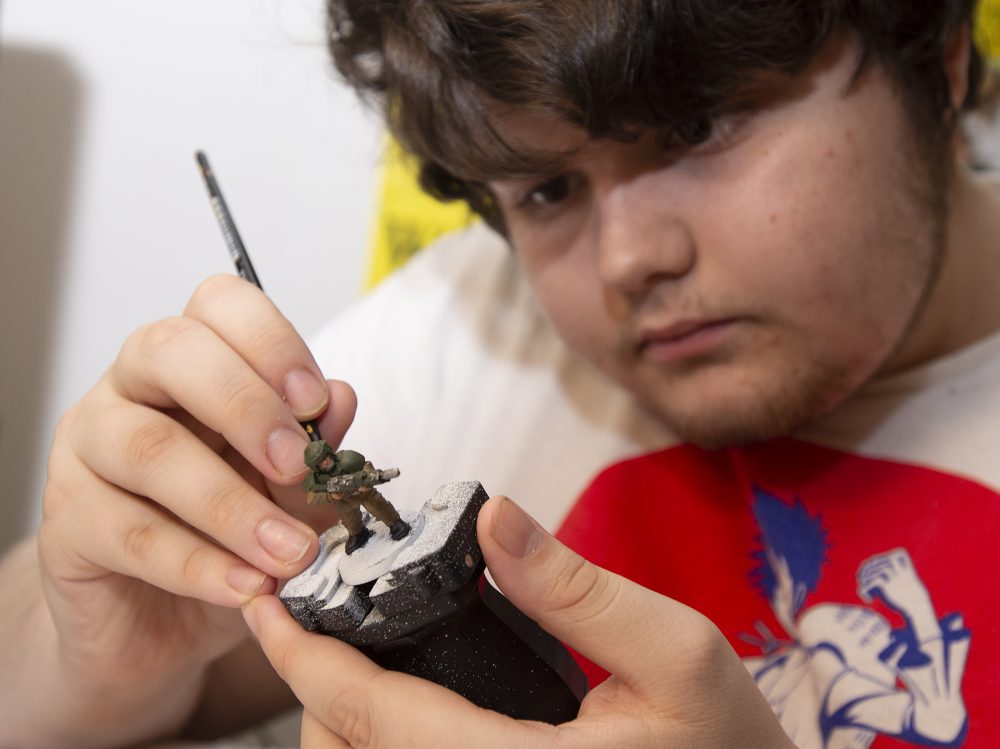
Seth Lightfoot
The Model Painter
“The skies the limit with this game. Creativity is the main goal,” Seth Lightfoot says while describing his passion towards the board game Warhammer 40,000. Models is what he calls the war men figurines that he hand paints with teeny tiny brushes, giving them immense detail in every crevice. He has a collection hundreds of these models and his collection will only keep growing.
“I really wanted to have an impressive army of something I made myself. When I sit here and look at my models, I get happy because they interest me so much. I really enjoy them.” Warhammer 40,000 is an interactive board game with army men that you must put together and build yourself. They are very small in size and take a speciality paint and brushes to be able to get the fine detail on them.
Lightfoot enjoys zoning into his own little world while painting his models so that he can one day soon play the action game with his friends who are collectors as well. Lightfoot was introduced to the game in high school when he found a book in the library that was all about the game. He has since became very inspired by it, and two years ago he began his collection.
“It can be tedious sometimes, especially when you mess up. But it feels good when you get it done and you look at the final model and think, ‘Wow, I did that. I personally made it look that cool.’ It’s a good feeling.”
Within his hobby, there are many components. There’s the game itself, plus painting the models, plus alternative ways of playing the game, which are taught in a book he owns. It’s been a motivation for Lightfoot since high school to start his journey playing this game, and he was able to earn the money to start collecting.
“It’s an expensive hobby, but to me, it’s very worth it in the end game.”
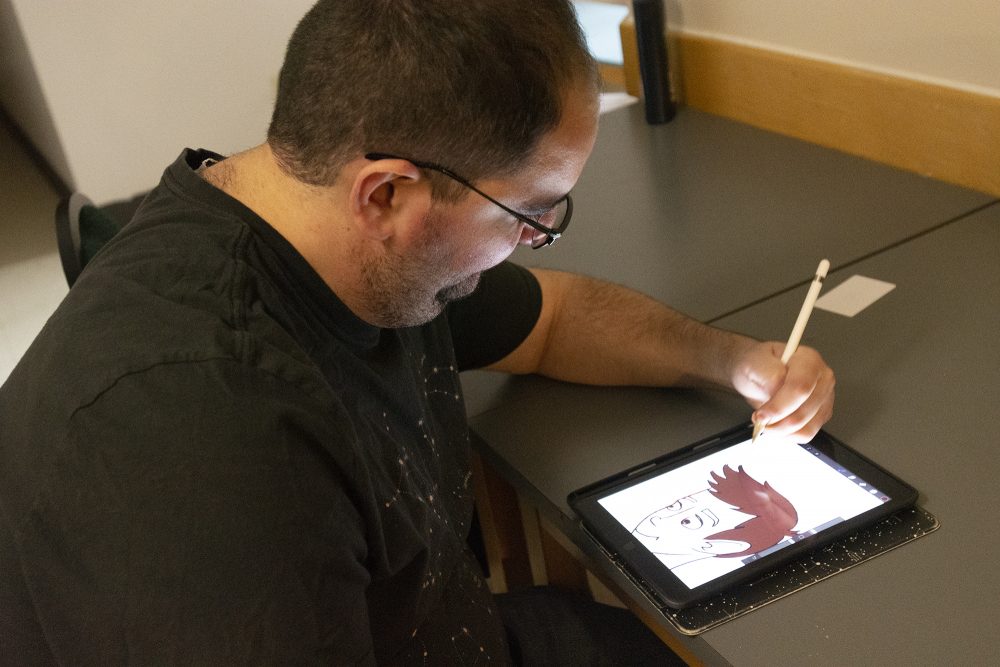
Rami Masri
The Digital Cartoonist
Rami Masri moved from Lebanon to Canada so that he could take the animation program here at Loyalist College. He always had a passion for drawing and is very well versed in realistic drawings and has a love of cartoons as well.
Masri has recently begun doing virtual drawings on a program called Procreate. He can create a drawing in only an hour, although he likes to take his time, especially when it comes to the fine details and colouring. In his program, he must make a short video using animations for his final project, and Masri’s idea for his video has lots of meaning to him.
He believes that every show, or video of sorts, should have a powerful message to it, and without a message, things can be tedious.
For his final video, he describes a character he has drawn on Procreate named Tim. Tim is being bullied at school, and bad names are flying at him, hitting him until he can’t take it anymore. Right when you think Tim has given up, nice words start flowing at him, and he gets the will to live again.
It’s a very powerful message with an important real-life lesson that words can really affect people and hurt them, but words can also bring people up and make their day. Masri is compiling a collection of cartoons that he’s drawing virtually, so that he may eventually make an art-related Instagram account to showcase his work.
